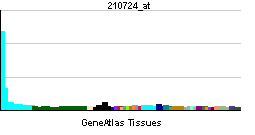EMR3: Difference between revisions
m (Bot: Automated text replacement (-{{SIB}} + & -{{EJ}} + & -{{EH}} + & -{{Editor Join}} + & -{{Editor Help}} +)) |
m (Robot: Automated text replacement (-{{WikiDoc Cardiology Network Infobox}} +, -<references /> +{{reflist|2}}, -{{reflist}} +{{reflist|2}})) |
||
| Line 60: | Line 60: | ||
==References== | ==References== | ||
{{reflist}} | {{reflist|2}} | ||
==Further reading== | ==Further reading== | ||
Revision as of 16:58, 4 September 2012
| Egf-like module containing, mucin-like, hormone receptor-like 3 | |||||||||||
|---|---|---|---|---|---|---|---|---|---|---|---|
| Identifiers | |||||||||||
| Symbols | EMR3 ; | ||||||||||
| External IDs | Template:OMIM5 HomoloGene: 50009 | ||||||||||
| |||||||||||
| RNA expression pattern | |||||||||||
 | |||||||||||
| More reference expression data | |||||||||||
| Orthologs | |||||||||||
| Template:GNF Ortholog box | |||||||||||
| Species | Human | Mouse | |||||||||
| Entrez | n/a | n/a | |||||||||
| Ensembl | n/a | n/a | |||||||||
| UniProt | n/a | n/a | |||||||||
| RefSeq (mRNA) | n/a | n/a | |||||||||
| RefSeq (protein) | n/a | n/a | |||||||||
| Location (UCSC) | n/a | n/a | |||||||||
| PubMed search | n/a | n/a | |||||||||
Egf-like module containing, mucin-like, hormone receptor-like 3, also known as EMR3, is a human gene.[1]
This gene encodes a member of the class B seven-span transmembrane (TM7) receptor family expressed predominantly by cells of the immune system. Family members are characterized by an extended extracellular region with a variable number of N-terminal epidermal growth factor (EGF)-like domains coupled to a TM7 domain via a mucin-like spacer domain. This gene is closely linked to the gene encoding egf-like molecule containing mucin-like hormone receptor 2 on chromosome 19. This protein may play a role in myeloid-myeloid interactions during immune and inflammatory responses.[1]
See also
References
Further reading
- Stacey M, Lin HH, Hilyard KL; et al. (2001). "Human epidermal growth factor (EGF) module-containing mucin-like hormone receptor 3 is a new member of the EGF-TM7 family that recognizes a ligand on human macrophages and activated neutrophils". J. Biol. Chem. 276 (22): 18863–70. doi:10.1074/jbc.M101147200. PMID 11279179.
- Strausberg RL, Feingold EA, Grouse LH; et al. (2003). "Generation and initial analysis of more than 15,000 full-length human and mouse cDNA sequences". Proc. Natl. Acad. Sci. U.S.A. 99 (26): 16899–903. doi:10.1073/pnas.242603899. PMID 12477932.
- Clark HF, Gurney AL, Abaya E; et al. (2003). "The secreted protein discovery initiative (SPDI), a large-scale effort to identify novel human secreted and transmembrane proteins: a bioinformatics assessment". Genome Res. 13 (10): 2265–70. doi:10.1101/gr.1293003. PMID 12975309.
- Bjarnadóttir TK, Fredriksson R, Höglund PJ; et al. (2005). "The human and mouse repertoire of the adhesion family of G-protein-coupled receptors". Genomics. 84 (1): 23–33. doi:10.1016/j.ygeno.2003.12.004. PMID 15203201.
- Olsen JV, Blagoev B, Gnad F; et al. (2006). "Global, in vivo, and site-specific phosphorylation dynamics in signaling networks". Cell. 127 (3): 635–48. doi:10.1016/j.cell.2006.09.026. PMID 17081983.
- Matmati M, Pouwels W, van Bruggen R; et al. (2007). "The human EGF-TM7 receptor EMR3 is a marker for mature granulocytes". J. Leukoc. Biol. 81 (2): 440–8. doi:10.1189/jlb.0406276. PMID 17108056.
This article incorporates text from the United States National Library of Medicine, which is in the public domain.